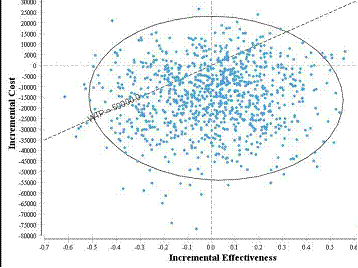Abstract
Follicular lymphoma is the most common indolent lymphoma, with median survival over 10 years. A large proportion of patients present with advanced, but asymptomatic disease. Three randomized controlled trials in the last 25 years have confirmed there is no detriment to deferred chemotherapy vs. upfront treatment with respect to overall survival in such patients. However, these studies were all comparing upfront toxic regimens. Single agent rituximab (R) is associated with less side-effects, thus there are advantages to giving it upfront and significantly delaying further more toxic and expensive treatments. Recently, Ardeshna et al. (2010) compared upfront rituximab to watchful waiting in asymptomatic stage II-IV follicular lymphoma, and demonstrated significant improvement in time to initiation of next treatment (TTINT). We performed a cost-effectiveness analysis comparing the two strategies.
We developed a Markov decision-analytic model to compare upfront R-induction (RI) X 4 weekly doses vs. a watch and wait (WW) strategy for a hypothetical cohort of 60 year old patients newly-diagnosed with asymptomatic low burden advanced stage follicular lymphoma. The model simulates the clinical course of patients over a lifetime horizon, with the end-points of quality-adjusted life years (QALYs) and incremental cost effectiveness ratio (ICER). The baseline probabilities used in the model were derived from a systematic review of published studies. Key health states include PF1 (progression-free 1), PD1 (1st progressive disease needing treatment), R-maintenance (2-year state progression-free post-PD1 receiving R q3mo), PF2 (post 2 years of R-maintenance), PD2/3/4 (subsequent progressions requiring salvage), PF3/4/5 (subsequent PF states post-salvage), palliation and death. The probabilities of transitioning from one state to another were evaluated on a 6-month cycle. The model incorporated data on health state utilities, which were derived from the literature. Direct costs were collected from a Canadian public health payer's perspective. Resource utilization was based on guidelines, literature and expert opinion. Cost information was obtained from hospital, provincial and national costing sources, as well as the literature, and presented in 2012 Canadian dollars. Costs and effects were discounted at 5%. All patients were assumed to be treated with bendamustine and rituximab (BR) upon PD1, followed by 2 years of R-maintenance. Patients were treated with a maximum of 3 lines of salvage therapy, after which they entered palliation for maximum of 2 cycles.
The quality-adjusted life expectancy was 6.70 QALYs for the RI strategy vs. 6.66 QALYs for the WW strategy, yielding an expected benefit from RI of 0.04 QALYs. Over a lifetime horizon, the total cost of the RI arm is $59061 and $74531 for the WW arm. The RI strategy dominates, as it is $15469 cheaper than the WW approach (Table 1). In one-way sensitivity analyses of key variables, effectiveness was sensitive to probability of PD2, PF4, age and time horizon. The model particularly favours RI in people under the age of 65. However, even at extreme end values for these variables that remain reasonable from the literature, the largest effectiveness difference in favour of WW is 0.06 QALYs (22 days) over the lifetime horizon. Thus overall the difference in either direction is minimal, demonstrating that the quality-adjusted life expectancy is essentially equivalent between the two strategies. Probabilistic sensitivity analyses (10 000 simulations) were performed. For the commonly accepted willingness to pay threshold of $50000, RI is the more cost-effective strategy 82% of the time (figure 1).
| Lifetime horizon outcome . | R-induction . | Watch and Wait . | Incremental effectiveness . |
|---|---|---|---|
| QALYs | 6.70 | 6.66 | +0.04 QALYs |
| Cost | $59061 | $74531 | -$15469.00 |
| ICER | R-induction dominates |
| Lifetime horizon outcome . | R-induction . | Watch and Wait . | Incremental effectiveness . |
|---|---|---|---|
| QALYs | 6.70 | 6.66 | +0.04 QALYs |
| Cost | $59061 | $74531 | -$15469.00 |
| ICER | R-induction dominates |
Incremental cost-effectiveness, RI vs. WW, given a WTP threshold of $50 000
In conclusion, rituximab monotherapy as an induction strategy for asymptomatic advanced stage follicular lymphoma is the dominant strategy from a cost-utility perspective over the standard watch and wait strategy, with neutral overall effectiveness, but significant cost minimization of fifteen thousand dollars per patient over the lifetime horizon. Particularly, it is the optimal strategy in patients under the age of 65 and should be recommended.
No relevant conflicts of interest to declare.
Author notes
Asterisk with author names denotes non-ASH members.


This feature is available to Subscribers Only
Sign In or Create an Account Close Modal